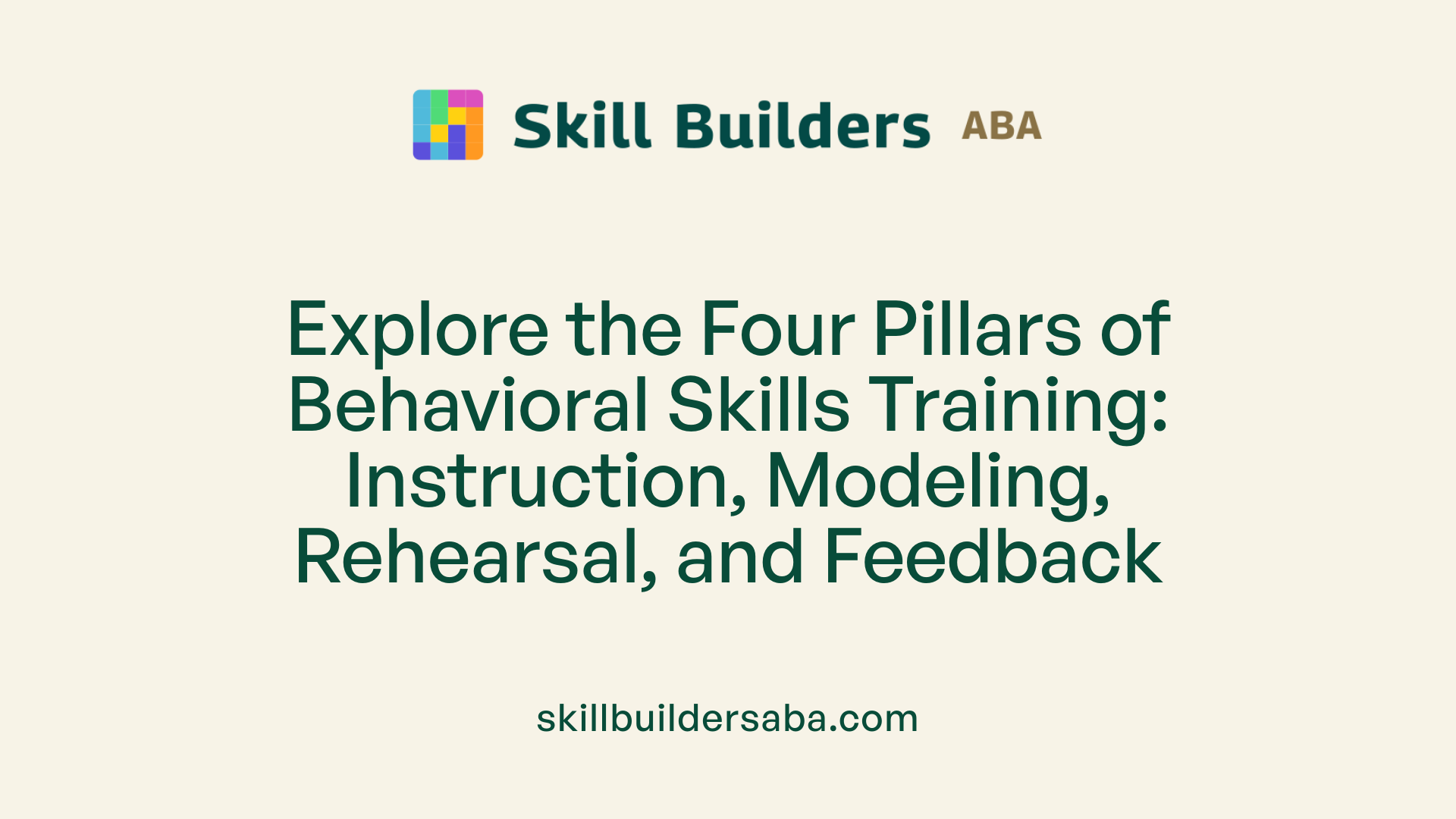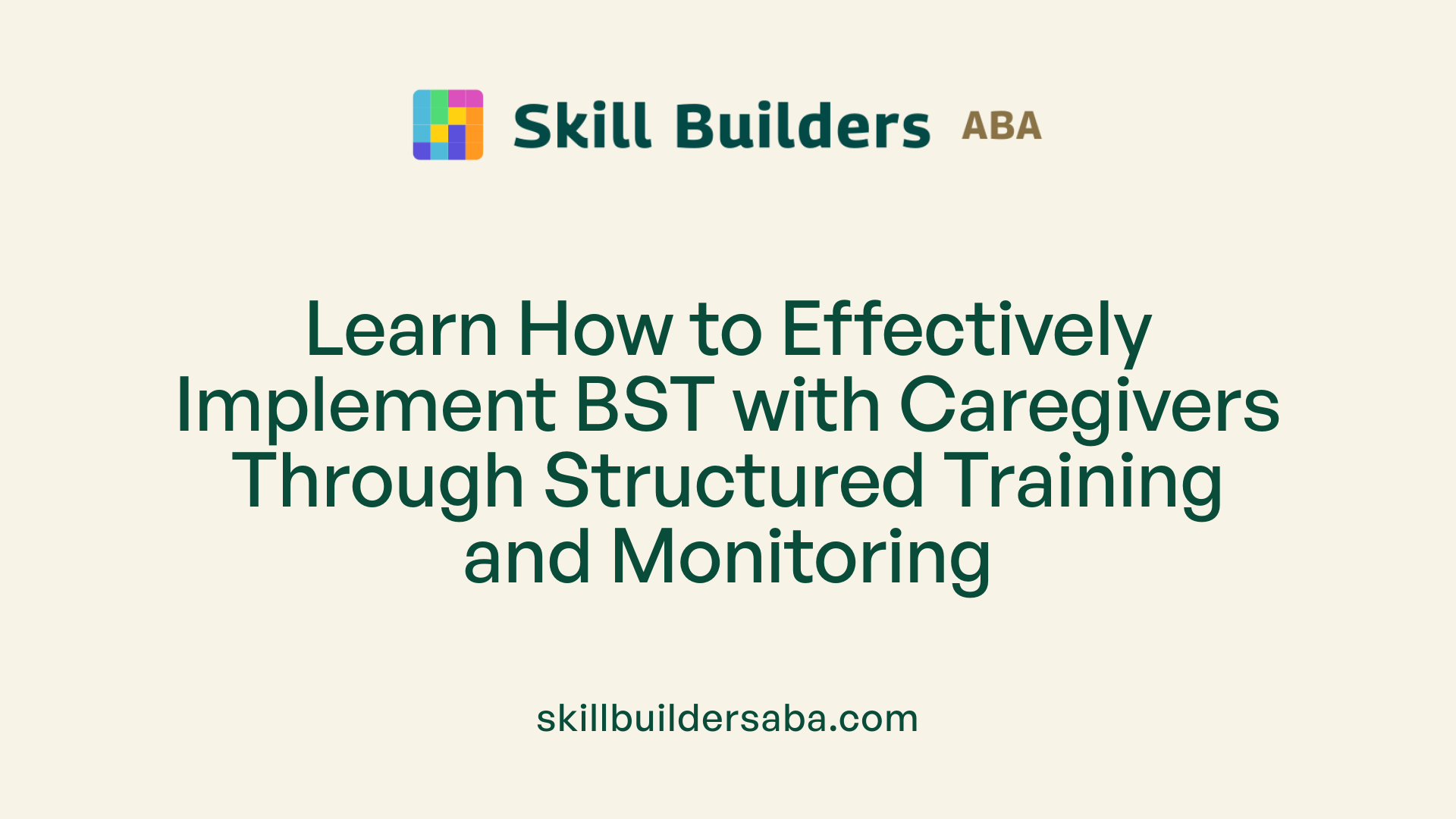Using behavior skills training with caregivers
Empowering Caregivers Through Evidence-Based Methods

Harnessing the Power of Behavior Skills Training (BST) in Caregiving
Behavior Skills Training (BST) has emerged as a cornerstone of effective caregiver education, especially within the context of supporting individuals with developmental disabilities. Its structured approach—comprising instruction, modeling, rehearsal, and feedback—facilitates the acquisition of vital skills that promote positive behavioral outcomes and enhance quality of life for both caregivers and those they support. This article explores the core components, practical applications, and innovative delivery methods of BST with caregivers, backed by recent research and real-world case studies.
Core Components of Behavioral Skills Training (BST)
 Behavior Skills Training (BST) is a comprehensive approach used to teach caregivers and staff essential behavioral techniques. It is highly effective in ensuring that learned skills are applied correctly in real-world settings.
Behavior Skills Training (BST) is a comprehensive approach used to teach caregivers and staff essential behavioral techniques. It is highly effective in ensuring that learned skills are applied correctly in real-world settings.
BST is built around four main components: instruction, modeling, rehearsal, and feedback.
Instruction involves delivering clear and concise explanations of the target behavior or skill. During this phase, trainers inform caregivers about the purpose and steps involved in the intervention, ensuring they understand what the skill entails.
Modeling provides an example of the correct execution of the behavior. Through live demonstration or video recordings, trainers show caregivers how to implement specific techniques properly, allowing learners to observe the correct form and sequence.
Rehearsal gives caregivers opportunities to practice the behavior in a controlled setting. This active practice ensures they are comfortable with the skill and can perform it independently. Rehearsal often involves role-play or real-time application.
Feedback is crucial for reinforcing correct behaviors and correcting errors. Trainers offer immediate, specific, and constructive feedback on the caregiver’s performance, promoting skill mastery.
In addition to these core components, BST frequently incorporates prompts and reinforcement strategies. Prompting supports skill acquisition when needed, while reinforcement encourages continued practice and confidence.
These components are integrated in a structured manner to facilitate the acquisition, generalization, and maintenance of effective behavioral practices across diverse populations, including caregivers of children with autism spectrum disorder (ASD) and other developmental disabilities.
Applications and Examples of BST in Caregiving Contexts

What are some examples of behavioral skills training (BST)?
Behavioral Skills Training (BST) is a flexible, evidence-based approach used to teach a variety of skills, especially in caregiving and educational settings. It combines instruction, modeling, rehearsal, and feedback to help caregivers and individuals acquire specific behaviors.
In practical terms, BST can be used to teach children or adults how to perform daily living tasks such as tying shoelaces, brushing teeth, dressing appropriately, or preparing simple meals. For example, a caregiver might be trained to teach a child to follow classroom rules or to engage in polite greetings. The training typically involves breaking down these complex behaviors into smaller, manageable steps and practicing them multiple times.
BST also effectively teaches social skills. Skills like sharing toys, initiating conversations, or responding appropriately in social situations are common targets. For instance, a caregiver could learn how to role-play scenarios with the individual to enhance their social interactions.
Communication skills, such as requesting items or expressing needs, are another focus. Caregivers can be trained to implement prompting procedures or reinforcement strategies that promote functional communication. Moreover, BST can be used to teach self-help routines, like grooming or meal routines, ensuring independence and safety.
Beyond skill acquisition, BST serves as a preventive strategy to reduce behavioral issues. Caregivers learn to implement interventions such as differential reinforcement or guided compliance, which help avoid problematic behaviors before they escalate.
Studies have shown that caregivers trained with BST rapidly improve in their ability to teach and implement these behaviors. The training results in observable, measurable changes that are often maintained over time and across different settings. This versatility makes BST an essential component of caregiver training programs—whether delivered face-to-face or via telehealth—allowing for broad application across diverse populations, including parents, grandparents, nannies, and caregivers of individuals with ASD or other developmental disabilities.
| Example Skill Type | Typical Target Behaviors | Implementation Techniques | Settings |
|---|---|---|---|
| Daily Living Skills | Dressing, grooming, meal preparation | Modeling, rehearsal, feedback | Home, clinical, educational |
| Social Skills | Greeting, sharing, turn-taking | Role-playing, reinforcement | Home, school, community |
| Communication Skills | Requesting, answering, commenting | Prompting, differential reinforcement | Home, telehealth interventions |
| Preventive Strategies | Guided compliance, antecedent interventions | Instructing, practice, feedback | Home, clinic, remote sessions |
By integrating these examples into caregiver training, BST supports the development of functional and socially valid behaviors. Its adaptability across different skills and settings underscores its value in promoting effective, compassionate caregiving and positive outcomes for individuals with diverse needs.
Implementing BST with Caregivers: Methods and Protocols

How is behavioral skills training (BST) used with caregivers?
Behavioral skills training (BST) with caregivers employs a structured, tailored approach to impart essential behavioral interventions. Professionals such as Board Certified Behavior Analysts (BCBAs) often form the core of this process. They provide caregivers with precise educational materials, clear demonstrations of specific strategies, and safe opportunities to practice these techniques.
Typically, sessions are scheduled based on the caregiver’s needs and the complexity of the skills being taught. Training includes didactic instruction, modeling of targeted behaviors, role-playing rehearsals, and immediate feedback. This combination ensures caregivers understand the procedures thoroughly and can implement them with high fidelity.
Progress is carefully monitored through systematic data collection, where caregivers’ performance during practice sessions is recorded. Ongoing review meetings help adjust the training plan, address any concerns, and reinforce learning. This iterative process not only enhances skill acquisition but also supports the generalization and maintenance of skills outside the training environment.
The ultimate goal of BST in caregiver training is to promote positive, measurable changes in child behavior, reduce caregiver stress, and improve family outcomes. By equipping caregivers with effective, evidence-based strategies, BST fosters greater independence for individuals with developmental disabilities and enhances the overall quality of life for the family.
Remote and Telehealth Delivery of BST

How can BST be implemented remotely or via telehealth with caregivers?
Behavior Skills Training (BST) has proven to be adaptable for remote delivery, allowing caregivers to receive effective training through telehealth platforms. This approach leverages digital tools such as video conferencing platforms like Zoom, Skype, or specialized health technology tools that enable real-time interaction.
In a typical telehealth BST session, training components such as instruction, modeling, rehearsal, and feedback are seamlessly integrated into the online format. Trainers provide didactic instruction through live video or pre-recorded videos, and demonstrate desired skills with visual models. Caregivers then engage in simulated practice, practicing the skills in their natural environment while receiving immediate coaching and feedback from trainers.
To support mastery, trainers often use techniques such as video recordings for self-review, structured practice protocols, and real-time prompting. Additionally, booster sessions can be scheduled periodically to reinforce skills, and peer support can be incorporated via group calls or online discussion forums.
Assessing fidelity remotely involves observing caregivers during actual or simulated implementation tasks via video recordings or live sessions. Digital tools facilitate the collection of performance data, which trainers review to ensure adherence to procedures and to provide corrective feedback.
Overall, telehealth-based BST is an effective, accessible way to train caregivers, especially in areas with limited access to in-person services. It maintains high levels of engagement and skill acquisition through personalized, flexible, and scalable training methods that suit diverse caregiver needs.
Evaluating Outcomes, Social Validity, and Long-term Impact
What are the outcomes of using BST with caregivers?
Behavioral Skills Training (BST) has demonstrated substantial positive effects when used to train caregivers of individuals with intellectual and developmental disabilities (IDD). Most studies report significant improvements in the implementation of targeted behaviors or skills. For example, caregivers practicing guided compliance, communication training, or functional life skills often increased their correct implementation rates from baseline levels around 30-40% up to nearly 98-99% after training.
These gains are typically captured through structured assessments such as multiple baseline or probe designs, confirming the robustness of BST’s effectiveness. Importantly, these improvements are not transient; follow-up evaluations show that caregivers maintain their newfound skills over time and across different environments.
In addition to measurable skill acquisition, caregivers consistently express increased confidence and positive attitudes toward their caregiving roles. This heightened social validity underscores how BST fosters not only behavioral change but also enhances caregiver motivation and satisfaction. Long-term data suggest that these skills are sustainable, leading to ongoing behavioral improvements in the individuals with IDDs, thereby improving their quality of life.
How well do skills learned with BST generalize and persist?
Research indicates that the skills acquired through BST generalize across different settings and maintain over extended periods. Generalization probes, conducted weeks after training, often reveal that caregivers continue to implement techniques with high fidelity, reflecting the durability of BST outcomes.
Sustained competence is further supported by follow-up assessments that demonstrate continued correct implementation, sometimes months after initial training. Factors such as booster sessions and ongoing feedback contribute to these long-term outcomes.
What about caregiver attitudes and confidence?
Caregivers frequently report a boost in their confidence and a positive view of the intervention process after BST. Studies highlight that caregivers feel more capable and satisfied with their ability to manage behaviors, leading to improved relationship quality and reduced caregiver stress.
Is there evidence for long-term effectiveness and ongoing impact?
Long-term impacts of BST extend beyond the training period. Follow-up data generally show that caregivers retain their skills and continue applying them effectively. Additionally, the reinforced behaviors of individuals with IDDs tend to be more consistent, translating into meaningful, lasting improvements.
In summary, BST's structured approach yields durable skill improvements in caregivers, with high levels of generalization and sustainability. The positive attitudes and increased confidence among caregivers further support its role in promoting lasting behavioral change for both caregivers and those they support.
Shaping the Future of Caregiver Training
Behavior Skills Training (BST) stands out as a powerful, evidence-based approach to equip caregivers with the skills necessary for fostering meaningful behavioral improvements in individuals with disabilities. Its adaptability for remote delivery expands access and increases its impact across diverse caregiving contexts. As research continues to validate its efficacy and refine implementation protocols, BST is poised to transform caregiver education, improve intervention fidelity, and ultimately enhance the lives of children, adults, and families around the world.
References
- Behavior skills training for family caregivers of people with ...
- THE EFFECTS OF BEHAVIORAL SKILLS TRAINING ON ...
- Using Behavioral Skills Training as a Tool for Effective Learning
- Effects of Using Telehealth-Based Behavioral Skills Training to ...
- Using Behavior Skills Training to Promote Caregivers' Generalized ...
- Training caregivers to teach communication skills to their child ...
- Using Behavioral Skills Training to Support Caregivers Through ...
- Using behavioral skills training to teach parents to implement three ...
- Generalization and maintenance of caregivers' effective instruction ...
- "Using Behavioral Skills Training Within the Pyramidal Training ...
.svg)














